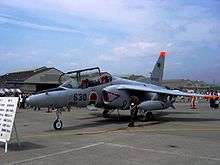301st Tactical Fighter Squadron (JASDF)
| 301st Tactical Fighter Squadron | |
|---|---|
| 第301飛行隊 | |
.jpg) 301st Sqn F-4EJ Kai (2014) | |
| Active | October 16, 1974 |
| Country |
|
| Branch |
|
| Part of | Central Air Defense Force, 7th Air Wing |
| Garrison/HQ | Hyakuri Air Base |
| Aircraft flown | |
| Fighter | McDonnell Douglas F-4EJ Kai |
| Trainer | Kawasaki T-4 |
The 301st Tactical Fighter Squadron (第301飛行隊 (dai-sann-byaku-ichi-hikoutai)) is a squadron of the 7th Air Wing of the Japan Air Self-Defense Force based at Hyakuri Air Base (Ibaraki Airport) in Ibaraki Prefecture, Japan. It is equipped with F-4EJ Kai Phantom II and Kawasaki T-4 aircraft.[1][2]
Along with the 302nd Tactical Fighter Squadron, the 301st is responsible for air defense of the Tokyo Metropolitan area.
As an F-4 squadron, it is expected to be one of the first JASDF squadrons to re-equip with the Lockheed Martin F-35A Lightning II.[3]
History
Prior to the 301st being formed as a full-fledged unit, it originally came into being as the Provisional F-4EJ squadron with only two aircraft in service on August 1, 1972. It was the first unit of the JASDF to fly the F-4. On February 25th the first operational conversation course for F-4EJ pilots was started. As of 2017 the squadron is still the operational conversion unit for pilots learning to fly the F-4.
The 301st squadron was founded at Hyakuri Air base on October 16th, 1973 as an F-4EJ Phantom II squadron. It was also equipped with Kawasaki-built Lockheed T-33A trainer/liaison aircraft.
On March 2nd, 1985 it moved to Nyutabaru Air Base in Miyazaki prefecture in Kyushu, swapping bases with the 204th Tactical Fighter Squadron which was flying the F-104J Starfighter but was due to convert to the F-15J and D-15DJ Eagle at Hyakuri.
In April 1991 the squadron updated from F-4EJ to F-4EJ Kai aircraft.
On October 31, 2016 as part of a JASDF reorganization it switched bases with the F-15J equipped 305th Tactical Fighter Squadron and returned to Hyakuri Air Base.[4]
One of the aircraft operated by the squadron (17-8440) was the last of the 5,195 F-4 Phantoms to be produced. It was manufactured by Mitsubishi Heavy Industries on May 21, 1981. "The Final Phantom" originally served with the 306th Tactical Fighter Squadron.[5]
As one of the two remaining JASDF F-4 fighter squadrons, it is expected to be the second JASDF squadron to operate the Lockheed Martin F-35A Lightning II[3] after the 302nd.[6]
Tail marking

The squadron emblem of the 301st squadron is a frog wearing a scarf. The word for "frog" in Japanese is kaeru, the same sound (but different characters) as the word for "come home" (safely). The frog is based on the Japanese common toad, which is found by Mount Tsukuba nearby Hyakuri airbase where the squadron was formed. The frog wears a scarf adorned with stars. The number of stars represent the air wing it belongs to, and as it currently belongs to the 7th Air Wing it has seven stars. When it belonged to the 5th Air Wing at Nyutabaru in Miyazaki Prefecture from 1985 to 2016 it had five.[4]
Aircraft operated

Fighter aircraft
Liaison aircraft
- Lockheed T-33A (1973-1993)
- Kawasaki T-4 (1991-)
In popular culture
The squadron appeared operating navalized aircraft in the Nuclear Aircraft Carrier Shinano 1990s novels by Shou Narumi (Mitsui Shinpei).
The squadron was also depicted in the 2012 Eureka Seven: AO manga. As the story took place in 2025, the squadron was depicted as having upgraded from F-4 to F-15J aircraft.
See also
References
| Wikimedia Commons has media related to 301st Tactical Fighter Squadron (JASDF). |
- ↑ Thompson, Paul JASDF - Order of Battle January 1, 2017 J-HangarSpace Retrieved January 31, 2017
- ↑ Hyakuri Air Base - About Force Retrieved January 31, 2017 (in Japanese)
- 1 2 Jennings, Gareth JASDF receives first F-35 at Luke AFB December 2, 2017 Jane's Retrieved August 16, 2017
- 1 2 Thompson, Paul JASDF Squadron Histories - 301st Squadron J-HangarSpace Retrieved August 14, 2017
- ↑ 17-8440 McDonnell Douglas F-4EJ Kai Retrieved September 28, 2017
- ↑ 三沢基地F-35A飛行隊は「第302飛行隊」に 百里F-4EJ改を整理 August 31, 2017 fly team.jp Retrieved September 13, 2017 (in Japanese)